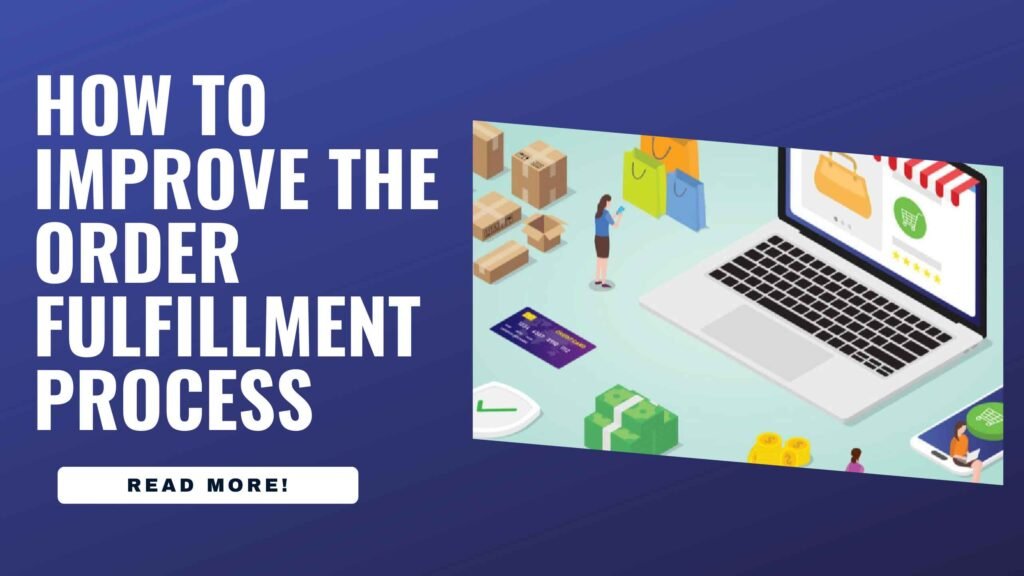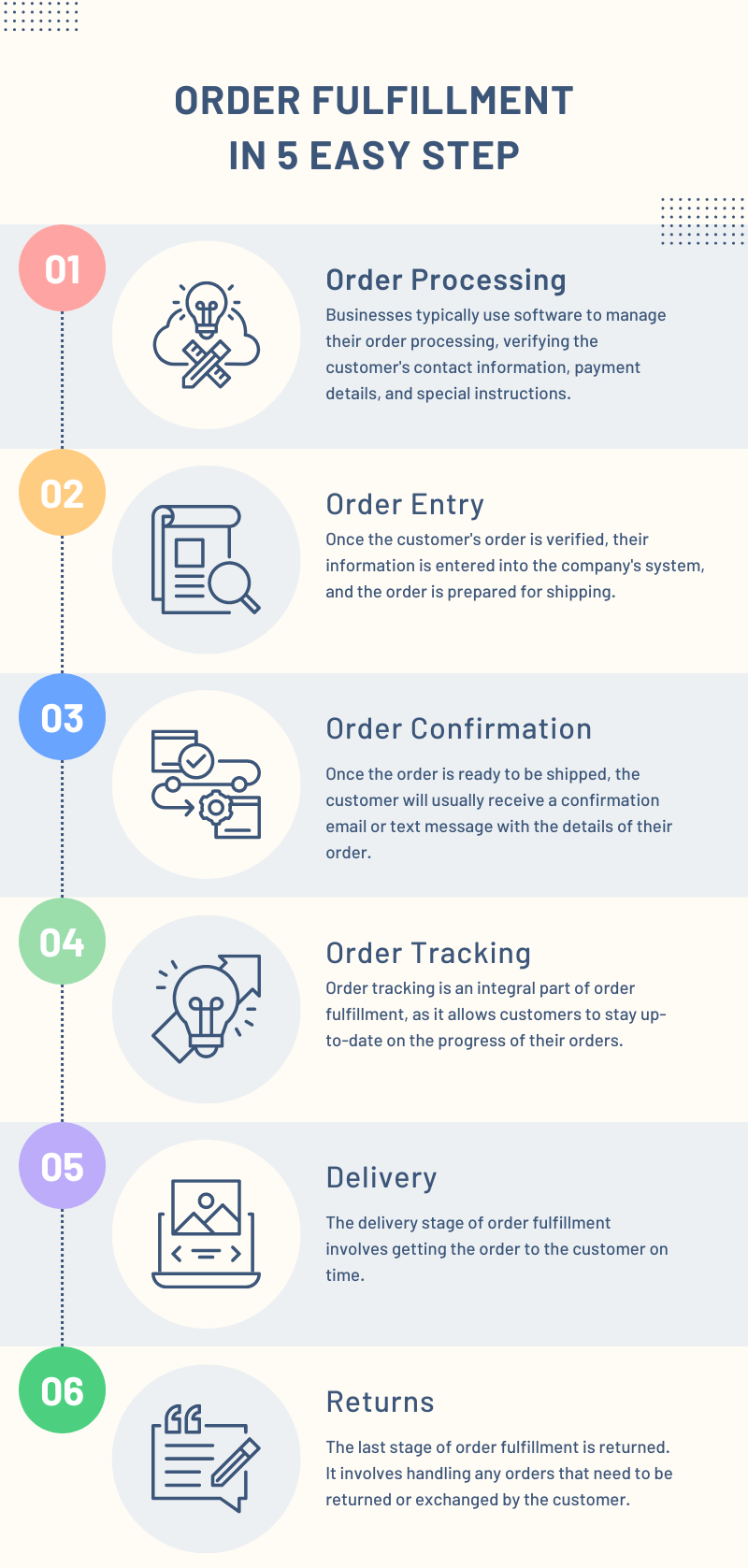Order Fulfillment Process – Streamline Your Operations Today

When optimizing your order fulfillment process, there are a few key steps to consider. From streamlining your inventory processes to facilitating communication with your customers, there are many ways to improve your order fulfillment efficiency.
We’ll discuss the various methods of strengthening your fulfillment process and how your business can benefit from each. We’ll also provide helpful tips to ensure that orders are fulfilled quickly, efficiently, and accurately. Whether you’re just starting with order fulfillment or looking to enhance your existing process, this blog post can help you maximize your success. Get ready to learn how to improve your order fulfillment process.
What is Order Fulfillment?
Order fulfillment is critical for businesses, regardless of size or industry. It takes orders from customers and ensures that the products or services they’ve ordered are delivered on time. It involves multiple steps, from the initial order to the product or service delivery.

Order fulfillment consists of several steps:
- order processing
- order entry
- order confirmation
- order tracking
- delivery, and returns
The key to successful order fulfillment has efficient processes to ensure that all of these steps are completed quickly and accurately.
To help you become a master of order fulfillment, let’s break it down into its various stages.
1. Order Processing
Businesses typically use software to manage their order processing, verifying the customer’s contact information, payment details, and special instructions. Once complete, you can submit the order to the appropriate warehouse or supplier.
2. Order Entry
Once the customer’s order is verified, their information is entered into the company’s system, and the order is prepared for shipping. It involves gathering the necessary items, packaging them, and getting them ready for shipment.
3. Order Confirmation
Once the order is ready to be shipped, the customer will usually receive a confirmation email or text message with the details of their order. It includes the ordered items, their shipping address, and estimated delivery date.
4. Order Tracking
Order tracking is an integral part of order fulfillment, as it allows customers to stay up-to-date on the progress of their orders. They can typically track their order, and it leaves the warehouse or supplier the moment it’s delivered to their home or business.
5. Delivery
The delivery stage of order fulfillment involves getting the order to the customer on time. Businesses will typically use a third-party shipping company to deliver their demands, such as UPS or FedEx.
6. Returns
The last stage of order fulfillment is returned. It involves handling any orders that need to be returned or exchanged by the customer. It can include providing a refund, offering an exchange, or replacing any damaged or defective items.
Improving the Order Fulfillment Process

Improving your order fulfillment can help ensure that orders are delivered quickly and accurately while reducing costs. Here are the ten steps to improving your technique:
- Understand Your Order Fulfillment Cycle Time
The first step to optimizing your order fulfillment is understanding your cycle time, including the time it takes to receive an order, pick, pack, and ship out the items. By understanding your cycle time, you can identify weaknesses and opportunities for improvement in your process.
- Minimize Warehouse Staff Decisions
Reducing manual decisions made by staff can help you speed up your orders. To do this, you should create standardized processes that your warehouse staff can quickly execute, which will help eliminate errors and increase efficiency.
- Use Inventory Classification
Inventory classification is a great way to organize and store your inventory. It can include categorizing items based on size, color, or other criteria, and it will help you quickly locate items when fulfilling orders.
- Differentiate Between Quotes and Orders
It is essential to differentiate between quotes and orders to ensure timely and accurate order processing. By having a straightforward process for when a quote turns into an order, you can streamline your order fulfillment and make sure orders are processed quickly and accurately.
It’s important to have enough inventory to quickly and efficiently fulfill orders. Too little inventory will cause delays and result in lost sales while keeping too much stock can lead to unnecessary costs.
- Incorporate Multi-Location Management and Support
If you have multiple warehouses or stores, it is important to have a system to manage and support them. It can include having strategies to ensure that inventory is distributed to the correct locations or having processes to ensure orders are fulfilled quickly and accurately.
- Streamline Inventory Processes
Streamlining your inventory processes can help your orders to be compiled efficiently. It can include automating processes, using barcodes to track inventory, and using software to keep track of inventory levels.
- Increase Transparency Increasing
Transparency can help you ensure that orders are fulfilled quickly and accurately. It can include providing customers with real-time updates on their orders, allowing customers to track their orders, and providing them with detailed order receipts.
- Offer Options for Viewing and Updating Pick Lists
Offering options for viewing and updating picklists is a great way to simplify. It can include allowing customers to view and edit their pick lists or allowing warehouse staff to quickly and accurately update them.
- Increase Picking Accuracy
Ensuring that orders are picked up accurately is essential to fulfilling your orders efficiently. It can include using software to keep track of pick lists, using barcodes to scan items, and using RFID tags to verify that one picked things correctly.
Implementation of the Strategies
The implementation of strategies is an essential part of achieving desired business outcomes. Strategies are the blueprints of an organization’s plans and must be implemented effectively to succeed.
Successful strategy implementation requires an organized and collaborative effort, and one cannot do it in isolation. Involving a cross-functional team helps to ensure that each department is aware of the strategy and is actively working to implement it.
- The first step in the strategy implementation process is to define the overall goal and objectives of the strategy. It is essential to be clear about what the procedure is trying to achieve and how it will benefit the organization. Once the goals and objectives are established, the team can start planning how to execute the strategy.
- The next step is to develop a timeline for implementing the strategy. It will help the team to break down the plan into achievable tasks and milestones. It is important to be flexible when creating a timeline, as unforeseen circumstances may arise that could affect the timeline. It is also important to involve key stakeholders in the strategy implementation process. These stakeholders can provide valuable insights into the strategy and help to identify potential problems and opportunities.
- Another important factor to consider is the resources needed for the strategy implementation. It includes the availability of personnel, financial resources, and technology. It is important to ensure that the budget and timeline are realistic and can be met.
- Finally, the team should monitor the progress of the strategy implementation. It helps identify any areas that need to be addressed and allows the team to make any necessary changes.
Conclusion
An improved order fulfillment process can help your business succeed by increasing customer satisfaction, improving efficiency, and reducing costs. With a streamlined, automated process, you can reduce errors and increase accuracy, which can help you deliver orders faster. It can help you build customer loyalty, improve customer satisfaction, and drive more sales. An improved fulfillment process can also free up resources to focus on other areas of your business, such as marketing and product innovation.
FAQ’s
Q1. What are the best practices for order fulfillment?
Best practices for order fulfillment include:
- Using real-time tracking and analytics to monitor the process.
- Leveraging automation and technology to improve accuracy.
- Providing clear communication with customers throughout the process.
Q2. What are the benefits of improving order fulfillment?
Order fulfillment can improve customer satisfaction, delivery times, and cost savings.
Q3. How to Identify Weaknesses in Your Process?
Identifying weaknesses in your process can help you make improvements and ensure that your method is as efficient and effective as possible. Here are a few tips for identifying weaknesses in your process:
- 1. Look for areas where your process takes longer than necessary or requires too many steps.
- 2. Ask those familiar with your process what they think can be improved or what areas could be simplified.
- 3. How your competitors do things may reveal areas where you can improve your process.
- 4. Ensure that your process uses the latest tools and techniques available.
- 5. Inefficient steps that slow down the process can be identified and addressed.
Q4. How can I track orders throughout the fulfillment process?
Depending on the size and complexity of your business operations, you may choose to use one of the following methods:
- EDI: Exchanging business documents in standardized digital format.
- Barcode Scanning: Simple method of tracking orders throughout the fulfillment process.
- OMS: Software system to manage the order fulfillment process.
- WMS: Software system to manage inventory & warehouse operations.
Q5. What are the benefits of Improving Your Order Fulfillment Process?
In addition, increasing customer satisfaction and loyalty can lead to cost savings and improved efficiency.
- Cost savings: Automating order fulfillment processes can reduce labor and shipping costs.
- Improved inventory management: Automation can reduce overstocking and improve accuracy.
- Improved efficiency: Automation can reduce waste and speed up order fulfillment.
- Improved customer satisfaction: Quicker processing, accurate tracking, and better communication lead to happier customers.
Q6. How can I reduce costs associated with order fulfillment?
You can reduce costs associated with order fulfillment by adopting more efficient order processing methods, reducing storage costs, and using more cost-effective shipping solutions.